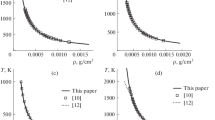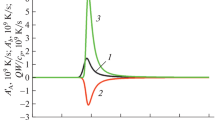Abstract
A software package consisting of the TETRAN-PRO and the COND-KINET-1 proprietary computer codes, as well as computational methods and models they are based on, is described. The TETRAN-PRO code calculates the composition and thermodynamic properties of a multicomponent reacting system under thermodynamic equilibrium conditions, including products of combustion or pyrolysis of organic and composite fuels. The difference of this code from similar ones is the use of the method of prevailing components, which is most effective as to convergence, computation time, and the range of parameters used. The code includes the necessary database of the original thermodynamic properties for 3000 individual substances. The TETRAN-PRO code’s capabilities are demonstrated by the results from calculation of mercury vapors' conversion in the combustion products of Kuznetsk and Berezovo coals. The COND-KINET-1 calculates the parameters of a condensation aerosol formed during the bulk condensation in a vapor-gas mixture flow. The process is described with a system of moment equations for the droplet size distribution function, which is closed by the equations of momentum and energy. A comprehensive approach, thermodynamic and kinetic, has been formulated to the description of the bulk condensation in multicomponent reacting systems based on the TETRAN-PRO and COND-KINET-1 codes. The approach’s capabilities are demonstrated by the example of numerically simulating the formation of environmentally dangerous submicron particles in burning coals according to the condensation mechanism. Data on the concentration and size distribution of the generated particles are obtained. The predicted data on the fractional composition of particles are compared with the experiment.







Similar content being viewed by others
Notes
Letter g means gaseous phase.
REFERENCES
N. M. Kortsenshtein, G. Ya. Gerasimov, and Yu. B. Shmel’kov, TETRAN-PRO, Software Registration Certificate No. 2016663354 (2016).
N. M. Kortsenshtein, L. V. Petrov, and Yu. B. Shmel’kov, COND-KINET-1, Software Registration Certificate No. 2017664075 (2017).
W. R. Smith and R. W. Missen, Chemical Reaction. Equilibrium Analysis. Theory and Algorithms (Wiley, New York, 1982).
V. E. Alemasov, A. F. Dregalin, A. P. Tishin, and V. A. Khudyakov, Thermodynamic and Thermophysical Properties of Combustion Products (Vses. Inst. Nauchn. Tekh. Inf. Akad. Nauk SSSR, Moscow, 1971–1978), Vol. 1–5 [in Russian].
G. B. Sinyarev, N. A. Vatolin, V. G. Trusov, and G. K. Moiseev, The Use of Computers for Thermodynamic Calculations of Metallurgical Processes (Nauka, Moscow, 1982) [in Russian].
F. E. Spencer and A. A. Orning, An Algorithm for Calculating Multiphase Chemical Equilibrium, Report No. 7786 (Bureau of Mines, Pittsburgh, 1973).
I. B. Rozhdestvenskii, K. K. Olevinskii, and V. P. Shevelev, “Composition and thermodynamic functions of a reacting gaseous or heterogeneous system,” Teplofiz. Vys. Temp. 7, 42–47 (1969).
G. Ya. Gerasimov, N. A. Zhegul’skaya, I. B. Rozhdestvenskii, E. V. Samuilov, and N. A. Sheveleva, “Thermodynamic and thermophysical properties of products of combustion and organic fuel conversion,” Mat. Model. 10 (8), 3–16 (1998).
N. M. Kortsenshtein and E. V. Samuilov, “Interaction of the processes of volume condensation and thermal emission of electrons in a multicomponent reacting system,” Izv. Ross. Akad. Nauk. Energ., No. 3, 169–185 (2005).
E. V. Samuilov, “Chemical thermodynamics and indifferent states,” Izv. Ross. Akad. Nauk. Energ., No. 1, 12–27 (2012).
E. V. Samuilov and N. A. Sheveleva, “Thermodynamic properties of coal combustion products,” Therm. Eng. 53, 842–847 (2006).
G. Ya. Gerasimov, “Thermodynamic investigation of the behavior of ash-forming components in burning coal,” J. Eng. Phys. Thermophys. 76, 98–103 (2003).
F. Frandsen, K. Dam-Johansen, and P. Rasmussen, “Trace elements from combustion and gasification of coal — An equilibrium approach,” Prog. Energy Combust. Sci. 20, 115–138 (1994). https://doi.org/10.1016/0360-1285(94)90007-8
D. Thompson and B. B. Argent, “Thermodynamic equilibrium study of trace element mobilization under pulverized fuel combustion conditions,” Fuel 81, 345–361 (2002). https://doi.org/10.1016/S0016-2361(01)00145-4
S. Liu, Y. Wang, L. Yu, and J. Oakey, “Thermodynamic equilibrium study of trace element transformation during underground coal gasification,” Fuel Process. Technol. 87, 209–215 (2006). https://doi.org/10.1016/j.fuproc.2005.07.006
I. B. Rozhdestvenskii, V. N. Gutov, and N. A. Zhegul’skaya, “Coefficients of approximation of the thermodynamic potential for substances formed by atoms of Al, B, C, Ca, Cl, F, H, K, Li, Mg, N, Na, O, P, S, Si, Ti in the temperature range up to 6000 K,” in Thermophysical Properties of Chemically Reacting Heterogenous Mixtures (Energ. Inst. im. G. M. Krzhizhanovskogo (ENIN), Moscow, 1973), Vol. 7, pp. 88–121.
L. V. Gurvich, “IVTANTERMO — Automatic data system of thermodynamic properties of substances,” Vestn. Akad. Nauk SSSR, No. 3, 54–65 (1983).
JANAF Thermochemical Tables, 2nd. ed., NBS-37 (American Chemical Society & American Inst. of Physics, Washington, 1971); JANAF Thermochemical Tables Supplement (American Chemical Society & American Inst. of Physics, Washington, 1974–1982).
J. L. Haas, Jr., G. R. Robinson, and B. S. Hemingway, “Thermodynamic tabulations for selected phases in the system CaO‒Al2O3‒SiO2‒H2O at 101.325 kPa (1 atm) between 273.15 and 1800 K,” J. Phys. Chem. Ref. Data 10, 575–670 (1981). https://doi.org/10.1063/1.555645
V. S. Vdovchenko, M. I. Martynova, N. V. Novitskii, and G. D. Yushina, Power-Generating Fuel of the USSR (Fossil Coals, Oil Shales, Peat, Fuel Oil and Combustible Natural Gas): Handbook (Energoizdat, Moscow, 1991) [in Russian].
A. Kolker, C. L. Senior, and J. Quick, “Mercury in coal and the impact of coal quality on mercury emissions from combustion systems,” Appl. Geochem. 21, 1821–1836 (2006). https://doi.org/10.1016/j.apgeochem.2006.08.001
C. E. Romero, Y. Li, H. Bilirgen, N. Sarunac, and E. K. Levy, “Modification of boiler operating conditions for mercury emissions reductions in coal-fired utility boilers,” Fuel 85, 204–212 (2006). https://doi.org/10.1016/j.fuel.2005.04.032
C. L. Senior, J. J. Helbe, and A. F. Sarofim, “Emissions of mercury, trace elements, and fine particles from stationary combustion sources,” Fuel Process. Technol. 65–66, 263–288 (2000). https://doi.org/10.1016/S0378-3820(00)00082-5
R. Meij and H. Winkel, “Mercury emissions from coal-fired power stations: The current state of the art in the Netherlands,” Sci. Total Environ. 368, 393–396 (2006). https://doi.org/10.1016/j.scitotenv.2005.09.083
J. C. Butcher, Numerical Methods for Ordinary Differential Equations (Wiley, New York, 2008).
L. E. Sternin, Fundamentals of Gasdynamics of Two-Phase Nozzles Flows (Mashinostroenie, Moscow, 1974) [in Russian].
N. M. Kortsenshteyn and L. V. Petrov, “Numerical simulation of bulk condensation in gas-vapor mixtures flowing through a nozzle,” Colloid J. 79, 333–340 (2017).
H. Pathak, J. Wolk, R. Strey, and B. E. Wyslouzil, “Co-condensation of nonane and D2O in a supersonic nozzle,” J. Chem. Phys. 140, 034304 (2014). https://doi.org/10.1063/1.4803202
J. Tomeczek and H. Palugniok, “Kinetics of mineral matter transformation during coal combustion,” Fuel 81, 1251–1258 (2002). https://doi.org/10.1016/S0016-2361(02)00027-3
L. Zhang and Y. Ninomiya, “Emission of suspended PM10 from laboratory-scale coal combustion and its correlation with coal mineral properties,” Fuel 85, 194–203 (2006). https://doi.org/10.1016/j.fuel.2005.03.034
D. W. Dockery, C. A. Pope, X. P. Xu, J. D. Spengler, J. H. Ware, M. E. Fay, B. G. Ferris, Jr., and F. E. Speizer, “An association between air pollution and mortality in six U.S. cities,” N. Engl. J. Med. 329, 1753–1759 (1993). https://doi.org/10.1056/NEJM199312093292401
The National Ambient Air Quality Standards (NAAQS) for Particulate Matter (PM): EPA’s 2006 Revisions and Associated Issues, Congressional Research Service Report No. 7-5700, RL34762 (Congressional Research Service, 2013). https://www.crs.gov
The List of Pollutants in Respect of Which Measures of State Regulation in the Field of Environmental Protection are Applied, Approved by Decree of RF Government No. 1316-r of July 8, 2015.
F. Vejahati, Z. Xu, and R. Gupta, “Trace elements in coal: Associations with coal and minerals and their behavior during coal utilization — A review,” Fuel 89, 904–911 (2010). https://doi.org/10.1016/j.fuel.2009.06.013
L. N. Lebedeva, N. M. Kortsenshtein, and E. V. Samuilov, “Thermodynamic assessment of the possibility of emission of submicron particles in the process of coal combustion,” Therm. Eng. 61, 911–916 (2014). https://doi.org/10.1134/S0040601514120052
N. M. Kortsenshteyn and L. V. Petrov, “Thermodynamic assessment of the possibility of emission of submicron particles in the process of coal combustion,” Therm. Eng. 65, 911–916 (2018). https://doi.org/10.1134/S0040601514120052
N. M. Kortsenshteyn, L. N. Lebedeva, L. V. Petrov, and E. V. Samuilov, “Simulation of parameters of submicron particles formed in combustion products of coals,” Colloid J. 77, 165–171 (2015).
D. Kashchiev, Nucleation. Basic Theory with Applications (Butterworth–Heinemann, Oxford, 2000).
N. A. Fuchs, Evaporation and Droplet Growth in Gaseous Media (Pergamon, New York, 1959).
A. P. Kryukov, V. Yu. Levashov, and N. V. Pavlyukevich, “Condensation coefficient: Definitions, estimations, modern experimental and calculation data,” J. Eng. Phys. Thermophys. 87, 237–245 (2014).
Author information
Authors and Affiliations
Corresponding author
Additional information
Translated by T. Krasnoshchekova
Rights and permissions
About this article
Cite this article
Kortsenshteyn, N.M., Gerasimov, G.Y., Petrov, L.V. et al. A Software Package for Simulating Physicochemical Processes and Properties of Working Fluids. Therm. Eng. 67, 591–603 (2020). https://doi.org/10.1134/S0040601520090049
Received:
Revised:
Accepted:
Published:
Issue Date:
DOI: https://doi.org/10.1134/S0040601520090049




